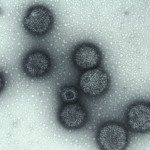Link to Pubmed [PMID] – 20961419
Link to DOI – 10.1186/1471-2164-11-586
BMC Genomics 2010 Oct; 11(): 586
A resequencing microarray called PathogenID v2.0 has been developed and used to explore various strategies of sequence selection for its design. The part dedicated to influenza viruses was based on consensus sequences specific for one gene generated from global alignments of a large number of influenza virus sequences available in databanks.For each HA (H1, H2, H3, H5, H7 and H9) and NA (N1, N2 and N7) molecular type chosen to be tested, 1 to 3 consensus sequences were computed and tiled on the microarray. A total of 12 influenza virus samples from different host origins (humans, pigs, horses and birds) and isolated over a period of about 50 years were used in this study. Influenza viruses were correctly identified, and in most cases with the accurate information of the time of their emergence.PathogenID v2.0 microarray demonstrated its ability to type and subtype influenza viruses, often to the level of viral variants, with a minimum number of tiled sequences. This validated the strategy of using consensus sequences, which do not exist in nature, for our microarray design. The versatility, rapidity and high discriminatory power of the PathogenID v2.0 microarray could prove critical to detect and identify viral genome reassortment events resulting in a novel virus with epidemic or pandemic potential and therefore assist health authorities to make efficient decisions about patient treatment and outbreak management.

